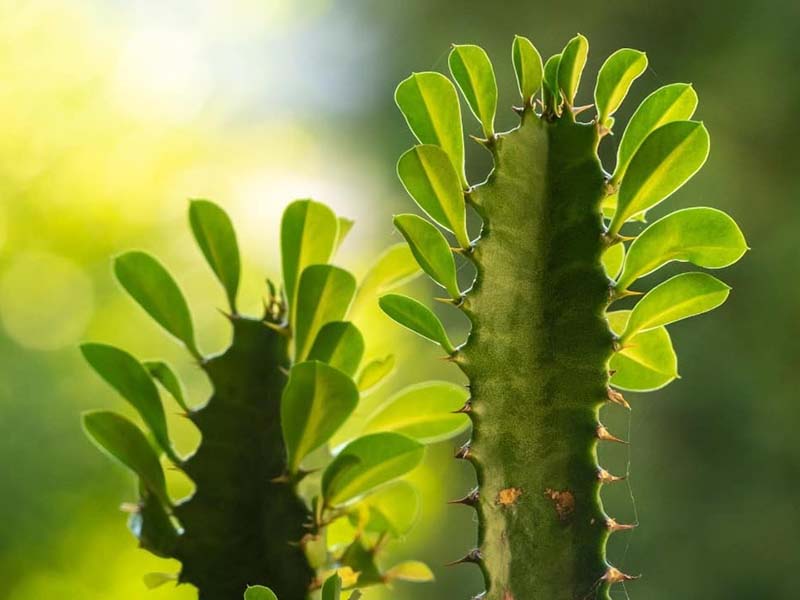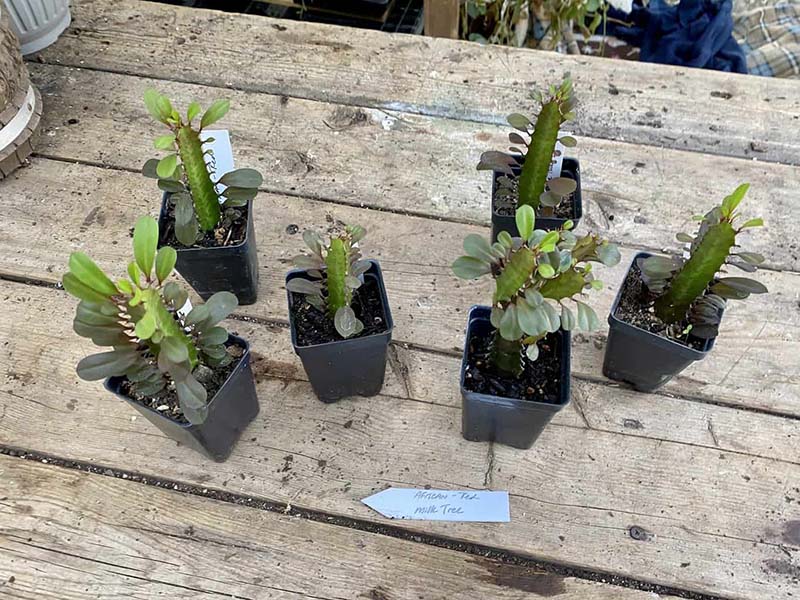The African milk plant (Euphorbia trigona) is native to Central Africa. Because of its quick and vigorous growth, it is frequently used as a hedge. Although it resembles a cactus (thus the names: candelabra cactus, cathedral cactus, friendship cactus, and good luck cactus), this plant is succulent. It has triangular stems with three unique sides sewn together with ridges. This plant remains lush and green throughout the growing season, with new growth sprouting a light green tint. The Rubra or Royal Red variety is well-known for its striking hue, which becomes deep red late in the season.
General Information
African milk tree growth rate is approximately 1 to 2 feet each year for a total height of 9 feet. However, when the African milk bush is cultivated as a houseplant, this plant will only reach half of its full size. African milk trees can be grown outside only in desert areas (parts of Texas, California, Florida, and Arizona) when nighttime temperatures stay over 50 °F.
The plant provides a stunning landscape addition not commonly seen in gardens across the United States. Plus, the African milk tree can even bloom! But we want to warn you that if you grow it indoors, then flowering is unlikely. But if you give your African milk tree everything you need, it will delight you with its cute white and yellow flowers. Now that you have an idea about this unique plant, we want to give you a couple of tips on caring for the African milk tree.
African Milk Tree Care
The African milk tree is famous as a beautiful landscape feature or container plant. Its impressive size makes it a sought-after plant among gardeners, even though the tree may require training through trimming and staking to obtain the ideal appearance. Because the African milk tree’s root system is small compared to its towering succulent body, it can easily topple over if not pruned properly.

This succulent is easy to propagate, like a cactus, by simply cutting off one of the ‘branches’ and rooting it in a potting media. (Always do this in gloves.) This plant grows hardy in Zones 9b through 11, and with winter protection, it can barely make it to Zone 8.
Light Requirements
Since African milk trees are succulents, they need slightly different care. The harsh pounding sun is not what you desire. They’re well adapted to heat coming from Central Africa, so African milk trees require either brilliant light or some sunshine for an hour or two. You may also place them outside during the summer if the site has partial shade.
They are ineffective in low-light situations. This plant requires plenty of light, and if you can’t provide it, a grow lamp is necessary. There will be little to no new growth if the amount of light obtained is insufficient. Fresh leaves will only develop on one side of the plant, and stems may curve.
Soil for African Milk Tree
These plants may be grown in a variety of growth media. Regular potting compost or soil, sandy soil, and specific cactus and succulent mixes are all acceptable; essentially, the mixture should be a sort of well-draining soil.
Because the roots like natural drainage, avoid using anything excessively compacted or heavy, such as 100 percent dirt. Also, keep in mind that they adore water, so if your mix is too “open” and free-draining, you’ll have to water them more regularly.

Watering Schedule
Watering is essential for caring for any plant, and Euphórbia trígona is no exception. Despite their reputation as a drought-tolerant plant, they are surprisingly thirsty, requiring a lot of water and drying up quickly in hot weather. Wait until the top inch or two of soil has completely dried before watering again. You may notice that the stems are a little squishy to the touch when they’re severely dehydrated. They are easily overwatered, so if you are unsure if your African milk bush requires additional water or not, wait a few days.
Humidity
Almost any humidity found in a typical house will be OK for these plants as long as adequate air movement. You may get into trouble with high humidity and stale rooms if you mix this with overwatering, but otherwise, you don’t need to worry about it.
Fertilizer
Give your African milk cactus a monthly feeding of half-strength diluted water-soluble fertilizer in the spring and summer (during the plant’s growing season). During the off-season, don’t feed your plant and allow it to become dormant naturally instead.
Selecting Temperature for African Milk Tree
They prefer warmer temperatures but will tolerate colder ones as well. If the weather is too hard, don’t expect much growth and reduce the amount of water you give your African milk bush to avoid root rot. The plant can withstand temperatures below freezing if required, but it isn’t a very tough plant, and prolonged exposure will almost likely harm it.
Repotting
Young tiny plants develop quickly and need to be repotted once a year until they become more established. You should be able to report it every two or three years.
Compared to the area required by the roots, you’ll see substantially more apparent growth. This simply implies that bigger plants are more likely to be housed in smaller pots.
Because the leaves and stems are readily damaged, wear protective gloves to avoid being harmed by the thorns and sap. If you cut your plant badly and it’s bleeding profusely, run the damaged portion under a cold tap for a minute or two until the bleeding stops.
Pruning
The African milk tree tends to be rather tall, with a thin and shallow root structure. As a result, elder plants may grow top-heavy or even tumble over, necessitating trimming. Always use gloves when pruning African milk trees and remove stems with a sharp, disinfected knife. The cut you make will dry over and make a callus on its own. To avoid an uneven burden on one side pulling the plant out of the ground, ensure the African milk tree is balanced on all sides.
African Milk Tree Propagation
Cuttings of the African milk tree are easily propagated. Because of the plant’s toxicity, wear strong gloves when multiplying it and wash your hands promptly if the milky sap gets on your skin. To grow the milk plant cactus from cuttings, follow these instructions:

- Gather a sharp knife or hand pruners, alcohol wipes, potting media, and a 4-inch container.
- Cut off one of the plant’s ‘branches’ at its base after sterilizing the blades of your knife or scissors with alcohol.
- Using cold running water, rinse the cutting until it stops leaking.
- Allow the cutting to remain in a dry area on a paper towel for five to seven days, out of direct sunshine, to allow the cut tip to callus over. (Note: Many growers skip the callus step and stick the cutting into the ground.)
- Plant the cutting in your pot once the callus has developed, with the end about an inch below the soil.
- To assist keep the cutting erect, add a layer of gravel on top of the soil.
- Place the pot in a warm, well-lit place with a temperature between 65 and 75 °F, but out of direct sunlight. Within two months, the cutting should have taken root.
- Transplant the plant into the slightly larger, 6-inch container as soon as you notice root development.
Although it is possible to cultivate an African milk tree from seed, it is not advised. Finding seeds may be challenging, and getting them to germinate can be much more complex and time-consuming. Instead, use the cutting procedure to propagate the plant.
Overwintering
The cold will kill African milk trees. Cacti won’t thrive in temps below 50 °F, so only plant them in the ground if your environment permits it. When the weather becomes colder, it’s time to bring the potted candelabra cactus indoors. To reduce humidity, place your succulent in a room with adequate air circulation and a brilliantly lit window with indirect sunshine.
African Milk Tree Blossom
Euphorbia trigona flowers throughout the summer, which can be a pleasant surprise. To blossom, these succulents must grow huge (over 3 meters tall) or have attained a particular level of maturity (over 20 years old). Flowering is nearly seldom seen in regulated indoor environments. Increase your chances by simulating their natural habitat as closely as possible and maintaining them healthy for decades. Blooms aren’t required for African milk trees to be attractive, and the leaves that sprout from the ridges are already eye-catching. However, if you’re looking for a flowering succulent, this is not the most excellent option.
Common Pests & Diseases
Pests and illnesses are seldom a problem for a healthy African milk tree. However, keep an eye out for mealybugs’ cotton-like threads. To get rid of them, make a solution with water and a few drops of mild dish detergent, then wipe the bugs away with a towel dipped in it. Bugs can be removed using a paper towel and rubbing alcohol or spraying them with water from a garden hose.
Overwatering your plant can lead to fungal issues like cork disease, which causes cork-like areas on the stems. Cut the diseased branches from the plant to save it. Succulents that have become yellow or brown may have developed root rot due to overwatering. You’ll almost certainly have to get rid of your tree in this instance.
Another common cause of brown spots on African milk trees can also be getting too much bright direct sunlight each day. Even though African Milk Trees are succulents, they can be harmed by excessively bright light.
Common Problems
Yellowing leaves are one of the most typical concerns with African milkweed cactus. The leaves on your plant might change shade and fall off, even with poor maintenance. Overwatering, underwatering, or low temperatures are the most common causes. It’s far simpler to avoid this problem than to solve it, so make sure your plant is in a warm location and water it just enough so that the soil dries out between watering but isn’t completely dry.
Are African Milk Trees Toxic
Both dogs and people can be poisoned by the sap of the African milk tree, which can irritate the skin, eyes, and mouth. It’s so strong that it can induce blisters, severe eye irritation, and even convulsions if consumed.
Conclusion
Overall, caring for an African milk plant is a breeze. Begin by selecting a healthy plant (or cutting) free of quiet places and pests. If you buy a potted Euphorbia trigona plant, ensure the root system and root ball are strong enough to keep the plant in the container. Check to see if the plant has been resting in the water. It should grow well and supply you with numerous healthy cuttings for many years if you start with a well-cared-for plant and continue to provide it with well-draining, not-too-rich soil and plenty of sunshine.

